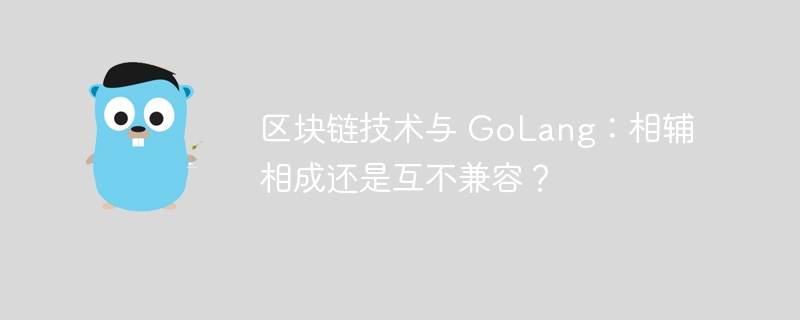
Blockchain technology and GoLang work together. GoLang’s concurrency and high performance meet the distributed processing needs of the blockchain, and the non-tamperability of the blockchain enhances the security of GoLang. Taking Hyperledger Fabric as an example, GoLang is used to write smart contracts. The specific implementation includes initializing the ledger, creating new assets, querying the owner, and transferring ownership. GoLang’s simple syntax and embedded concurrency simplify the development and maintenance of complex blockchain contracts.

Blockchain technology and GoLang: complementary
Blockchain technology relies on its immutable, transparent and secure features. It is attracting widespread attention in all walks of life. GoLang, a modern programming language known for its performance, concurrency, and syntactic simplicity, is becoming a popular choice for building blockchain applications.
Technical Synergy
GoLang’s concurrency and high performance are well suited to the distributed and highly intensive processing needs of blockchain. In addition, GoLang's built-in goroutine and channel mechanisms can easily implement parallel processing, thereby improving the throughput and response time of blockchain applications.
The immutability and security features of blockchain technology complement GoLang’s type safety and memory management capabilities. GoLang’s strong type system helps prevent errors and ensure code robustness, which is critical for blockchain applications involving sensitive data and financial transactions.
Practical Case: Hyperledger Fabric
Hyperledger Fabric is a popular blockchain framework that leverages GoLang to build its core components. Fabric’s chaincode (smart contract) is entirely written in GoLang.
The following is a simple example showing how to use GoLang to create a chaincode in Fabric:
import (
"fmt"
"strconv"
"strings"
"github.com/hyperledger/fabric-contract-api-go/contractapi"
)
// SmartContract 定义链码合约
type SmartContract struct {
contractapi.Contract
}
// InitLedger 初始化账本数据
func (s *SmartContract) InitLedger(ctx contractapi.TransactionContextInterface) error {
assets := []string{"asset1", "asset2", "asset3"}
owners := []string{"Tom", "Jerry", "Spike"}
for i, asset := range assets {
err := ctx.GetStub().PutState(asset, []byte(owners[i]))
if err != nil {
return fmt.Errorf("failed to put to world state: %v", err)
}
}
return nil
}
// CreateAsset 创建新资产
func (s *SmartContract) CreateAsset(ctx contractapi.TransactionContextInterface, assetID string, owner string) error {
err := ctx.GetStub().PutState(assetID, []byte(owner))
if err != nil {
return fmt.Errorf("failed to put to world state: %v", err)
}
return nil
}
// ReadAsset 查询资产所有者
func (s *SmartContract) ReadAsset(ctx contractapi.TransactionContextInterface, assetID string) (string, error) {
value, err := ctx.GetStub().GetState(assetID)
if err != nil {
return "", fmt.Errorf("failed to get state: %v", err)
}
if value == nil {
return "", fmt.Errorf("asset %s not found", assetID)
}
return string(value), nil
}
// TransferAsset 转移资产所有权
func (s *SmartContract) TransferAsset(ctx contractapi.TransactionContextInterface, assetID string, newOwner string) error {
value, err := ctx.GetStub().GetState(assetID)
if err != nil {
return fmt.Errorf("failed to get state: %v", err)
}
if value == nil {
return fmt.Errorf("asset %s not found", assetID)
}
err = ctx.GetStub().PutState(assetID, []byte(newOwner))
if err != nil {
return fmt.Errorf("failed to put to world state: %v", err)
}
return nil
}This chaincode implements four functions:
GoLang’s simple syntax and embedded concurrency make writing and maintaining Complex blockchain contracts become easy, ensuring application scalability, security and efficiency.
The above is the detailed content of Blockchain technology and GoLang: complementary or incompatible?. For more information, please follow other related articles on the PHP Chinese website!
 How to define variables in golang
How to define variables in golang
 What are the data conversion methods in golang?
What are the data conversion methods in golang?
 What is blockchain web3.0
What is blockchain web3.0
 What are the commonly used libraries in golang?
What are the commonly used libraries in golang?
 What does STO mean in blockchain?
What does STO mean in blockchain?
 How to make money with blockchain
How to make money with blockchain
 What is the inscription in the blockchain?
What is the inscription in the blockchain?
 What is the difference between golang and python
What is the difference between golang and python




